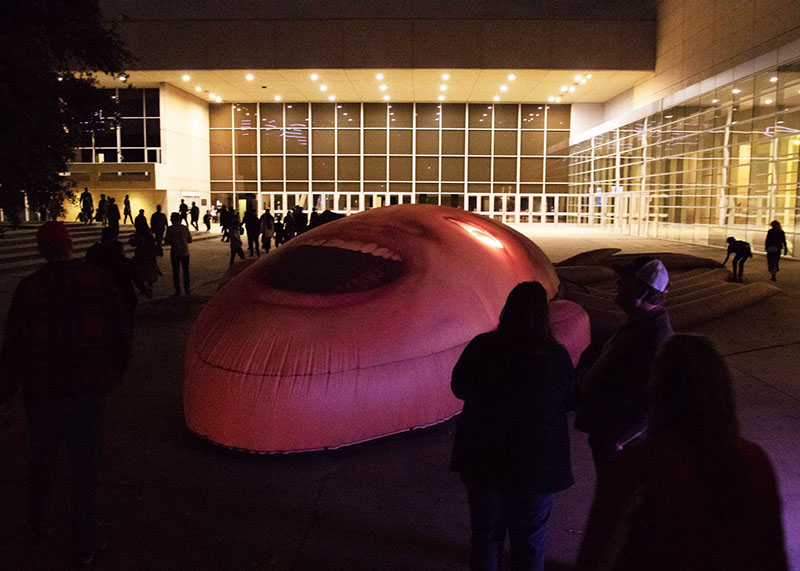< Back
![]()
Gong Tau, a potent form of Southeast Asian black magic, is performed by people flying kites from their bodies: Beginners fly kites that take the form of their organs, whereas masters fly kites that emulate their heads. Throughout Yang’s childhood, she often dreamt of the head of a ghost approaching her in the dark. She also dreamt that she was dead and floating above Shanghai, her birthplace, and smiling down at the city. During these dreams, she says, “I could never feel my body.” Upon discovering Gong Tau, she immediately connected it with her dreams and then created Power of Will (2017), which is a physical manifestation of the artist’s head as a large, inflatable kite. Power of Will also relates to two of her previous works: LuYang Delusional Mandala (2015) and LuYang Gong Tau Kite (2016), the former of which features a 3D scanned avatar of herself and the latter shows this avatar flying through the sky.
Born and based in Shanghai, Lu Yang graduated from the China Academy of Art in 2010. Yang uses a variety of media, including video, installation, animation and digital painting. The artist explores existential issues about the nature of life and where it resides. Armed with strategies taken from science, religion, psychology, neuroscience, medicine, gaming, pop culture and music, among others, Yang overrides the often delusional belief that humans are privileged within this universe. Instead, she highlights the biological and material determinants of our condition, reminding us of our transient and fragile existence, but with an edge of dark humor that leaves no room for sentimentality.
Yang’s works have been featured in important solo and group exhibitions at the UCCA (Beijing), Mwoods museum (Beijing), Centre Pompidou (Paris), 56th Venice Biennale 2015 Chinese Pavillion, 3rd Istanbul Design Biennial, Liverpool Biennial 2016, Shanghai Biennale 2012, Montreal International Digital Art Biennial2016, Musée d’art contemporain of Lyon, Momentum (Berlin), Tampa Museum of Art, and the 5th Fukuoka Asian Art Triennale.

Lu Yang: Power of Will, Courtesy of SOCIÉTÈ Berlin, photo by Paperlyte,
installation at Dallas City Hall
installation at Dallas City Hall
LU YANG:
Power of Will
Inflatable Sculpture
Gong Tau, a potent form of Southeast Asian black magic, is performed by people flying kites from their bodies: Beginners fly kites that take the form of their organs, whereas masters fly kites that emulate their heads. Throughout Yang’s childhood, she often dreamt of the head of a ghost approaching her in the dark. She also dreamt that she was dead and floating above Shanghai, her birthplace, and smiling down at the city. During these dreams, she says, “I could never feel my body.” Upon discovering Gong Tau, she immediately connected it with her dreams and then created Power of Will (2017), which is a physical manifestation of the artist’s head as a large, inflatable kite. Power of Will also relates to two of her previous works: LuYang Delusional Mandala (2015) and LuYang Gong Tau Kite (2016), the former of which features a 3D scanned avatar of herself and the latter shows this avatar flying through the sky.
Bio
Born and based in Shanghai, Lu Yang graduated from the China Academy of Art in 2010. Yang uses a variety of media, including video, installation, animation and digital painting. The artist explores existential issues about the nature of life and where it resides. Armed with strategies taken from science, religion, psychology, neuroscience, medicine, gaming, pop culture and music, among others, Yang overrides the often delusional belief that humans are privileged within this universe. Instead, she highlights the biological and material determinants of our condition, reminding us of our transient and fragile existence, but with an edge of dark humor that leaves no room for sentimentality.
Yang’s works have been featured in important solo and group exhibitions at the UCCA (Beijing), Mwoods museum (Beijing), Centre Pompidou (Paris), 56th Venice Biennale 2015 Chinese Pavillion, 3rd Istanbul Design Biennial, Liverpool Biennial 2016, Shanghai Biennale 2012, Montreal International Digital Art Biennial2016, Musée d’art contemporain of Lyon, Momentum (Berlin), Tampa Museum of Art, and the 5th Fukuoka Asian Art Triennale.
